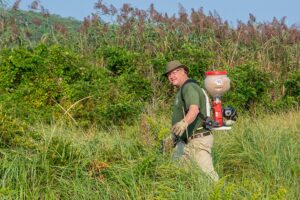EASTHAM — West Nile virus, a mosquito-borne illness that appears on Cape Cod annually, has been detected in a sample of the insects in the Fort Hill area of Eastham. The disease, which was also identified in a mosquito sample from West Barnstable, appears among Cape Cod’s mosquitoes in midsummer and fall.

“Almost every summer since it came into Massachusetts, we’ve found mosquitoes that were positive for West Nile virus,” said entomologist Gabrielle Sakolsky, superintendent of the Cape Cod Mosquito Control Project, the quasi-governmental agency that detected the virus in Eastham.
The project maintains 20 mosquito traps distributed across Cape Cod; seven of them are on the Outer Cape. The Eastham sample that contained West Nile virus was collected on Aug. 24 and consisted of 10 mosquitoes. Because the samples are measured as a batch, it is unknown how many of those mosquitoes were carrying the disease.
The Mosquito Control Project also monitors for the Eastern equine encephalitis (EEE) virus, which has not been detected on Cape Cod at all this year. The Mass. Dept. of Public Health has assessed the risk of EEE on the Outer Cape as “remote” — the lowest possible level of risk.
West Nile virus infects thousands of Americans annually. It was first identified in the U.S. in 1999 and spread to Cape Cod in 2003. From 2011 to 2020, 148 cases of the virus were identified in people in Massachusetts. Seven of those cases, or 5 percent, were lethal.
“I wouldn’t spend a lot of time being anxious about West Nile virus, but it’s very appropriate to take some steps to prevent mosquito bites,” said Catherine Brown, an epidemiologist with the Mass. DPH. The state agency currently lists the risk of West Nile virus on the Outer Cape as “low,” and Brown said that this year has seen fewer cases than usual in the state compared to most years.
But, Sakolsky said, “It doesn’t mean there’s no risk.”
West Nile virus is usually first detected here by the Mosquito Control Project’s monitoring program starting in July. As the summer goes on, the virus becomes more common in mosquito populations. Later in the season, even though there may be fewer mosquitoes, they are more likely to be carrying the disease, said Sakolsky.
Most West Nile virus infections are not dangerous. According to the Centers for Disease Control, only 20 percent of people infected with the virus develop symptoms. They are usually flu-like: fever, chills, headaches, and vomiting. Less than 1 percent of those infected develop serious symptoms like meningitis and brain inflammation. Among those infected, the chances of dying are around 1 in 1,500, though they are higher among people over 60 and those with medical conditions like cancer, diabetes, or hypertension.
The disease is primarily transmitted by birds and mosquitoes. When the virus first reached the U.S., it was detected among a flock of American crows in Queens, N.Y. Some mammals can contract the disease as well. Besides humans, horses, dogs, and cats have been infected with it, though the latter two animals rarely show any symptoms at all.
The best way to mitigate the spread of West Nile virus is through mosquito population control. And since mosquitoes need standing water to reproduce, and eggs can develop into adults in as little as a week, the Mosquito Control Project works to lower the number of insects by removing sources of standing water. If the sources cannot be removed — say, in wetland areas — they use larvicide to make the water inhospitable to developing mosquitoes.
This process uses bacteria known as Bti and Bacillus sphaericus, which break down cells in the larvae’s digestive system, killing the mosquitoes. These bacteria affect only mosquitoes and their fly relatives, leaving other insects, fish, birds, and mammals unharmed. If mosquito larvae are too developed to be killed by the bacteria, Mosquito Control will instead drop mineral oil into the water to kill them.
To stop the proliferation of mosquitoes, Sakolsky said, “go around your yard after rain, dump out all that standing water, and you won’t be raising these mosquitoes on your property.” Her organization recommends draining sources of water around the house, such as clogged roof gutters, buckets, tires, and birdbaths, to prevent mosquitoes from laying their eggs. It also recommends stocking ornamental ponds with koi or goldfish to eat mosquito larvae and ensuring that swimming pools are well filtered, as chlorine alone will not keep pools mosquito-free.
Both Brown and Sakolsky said that the larvicide is a more effective mechanism of mosquito control than spraying yards to kill adult mosquitoes. Using conventional spraying mechanisms “is a very temporary approach,” said Sakolsky, whereas controlling standing water and deploying larvicide is the more “permanent solution.”
To keep yourself safe from West Nile virus, public health experts recommend wearing mosquito repellent with an EPA label on it. These will contain approved active ingredients such as DEET, permethrin, picaridin, IR3535, or lemon eucalyptus oil. As temperatures cool, the DPH also recommends wearing long-sleeved tops and long pants when outdoors to minimize bites.
“It’s just a good idea to take steps to prevent getting bitten by mosquitoes,” said Brown. “Even if you’re not in a hotspot.”
“It’s never good to be bitten by a mosquito,” said Sakolsky. “It’s like ticks: you don’t know what they’re carrying.”
